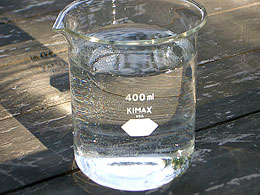- Home
- Learn about salinity
- Get to know your site
- Design a landscape
- Solve a problem
- Other information
Salinity Management Guide

Assessing the chemistry of irrigation water
The quality of the water used to irrigate a landscape affects the future salinity of the landscape's soil. That's because, over time, some of the salt-related ions dissolved in the irrigation water may combine in the soil, forming salt, which then may accumulate. Such an accumulation may lead to even higher concentrations of the ions, injuring salt-sensitive plants. Under certain circumstances, it might also decrease the soil's permeability to water. For these reasons, it's important to obtain certain information about the chemistry of the irrigation water used for a landscape.
Information you may wish to acquire includes:
- Total dissolved salt, or TDS, expressed in milligrams per liter (mg/L)
To measure TDS, a known volume of water is evaporated and any remaining precipitate is weighed. This can be done only in a laboratory. However, the procedure by which a commercial laboratory would make this measurement is relatively time-consuming and therefore expensive. Fortunately, a quicker measure of total salinity is available: EC (see below). Excessive salinity adversely affects plants, especially those species that are not very salt-tolerant.
- Electrical conductivity, or EC, expressed in decisiemens per meter (dS/M) or in the numerically equivalent millimhos per centimeter (mmhos/cm)
The greater the concentration of salt ions in a water, the more the water is able to conduct electricity. Thus, measuring the EC of an irrigation water (denoted ECw or ECiw) is a simpler and less expensive way to determine a water's total salinity than measuring TDS directly.
- Concentrations of particular ions in the water, expressed in mg/L
Ions of interest often include those of sodium (Na+), calcium (Ca2+), magnesium (Mg2+), chloride (Cl-), carbonate (CO32-), bicarbonate (HCO3-), and sulfate (SO42-). The concentration of these and other ions typically are expressed in milligrams per liter (mg/L). Excessive concentrations of these ions can have adverse effects on plants, such as abnormal yellowing of leaves, stunted growth, and unsightly whitish deposits on leaves.
- Sodium absorption ratio, or SAR
This unitless ratio is calculated based on the concentrations of sodium ion (Na+), calcium ion (Ca2+), and magnesium ion (Mg2+). Water that has a high sodium absorption ratio may over time decrease a soil's permeability, particularly if the soil consists predominantly of clay.
- Concentration of boron (B), expressed in mg/L
An excess of this element may result in injury to plants.
- pH
Defined as the negative of the logarithm of the hydrogen ion activity, this parameter is unitless and ranges from zero to 14. High pH can affect plants' uptake of nutrients and water. Low pH can also cause problems. An intermediate value of pH, 6.5 to 7.5, is generally optimal.
If recycled water is used for irrigation, knowing about other parameters is also helpful. Particulars regarding the more important ones are as follows.
- Plant nutrients dissolved in the water, expressed in mg/L
Such nutrients can include nitrate nitrogen (NO3-N), ammonia nitrogen (NH3-N), or organic nitrogen (Org-N). They also typically may include potassium (K), and phosphorus (P). The phosphorus may be in the form ortho-phosphate (PO4-P), or elemental phosphorus (P). Recycled water may contain enough of certain nutrients to lessen the need to fertilize.
- Residual chlorine (Cl2), expressed in mg/L
Recycled water sometimes contains chlorine left over from the disinfection process. If the concentration is high enough, such residual chlorine can be toxic to plants.
- Suspended solids, expressed in mg/L
Without the precautionary use of filters, solid particles present in the water may eventually plug valves and sprinklers or other types of emitters. As the water carrying them percolates into the soil, the particles may also partially fill in the spaces between coarser-textured particles of soil, eventually leading to a decrease in the soil's permeability. Suspended solids present far less of a concern for recycled water treated to a tertiary level than for water treated to a secondary level.
Some of the measured levels of parameters mentioned above may be available from the water's supplier. In any case, the information can be obtained by sampling the water and submitting the samples to an analytical laboratory.
| « Previous page | Next page » |